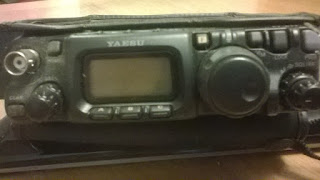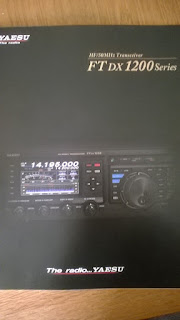 A word of advice
A word of advice
All of these people were all enthusiastic and determined to become Amateur Radio operators. So what went wrong? Why wasn't there a higher success rate? What went wrong was a lack of lead time and mis-communication. Some had learned of the Ham Cram session only three days beforehand. The information about the session was directed to the participants through their local municipal OEM directors. Middlesex County OEM did their due diligence by sending out the information in plenty of time, but we all know that information that goes through the chain-of-command can travel particularly slowly, especially if the "powers that be" aren't all that familiar with the information they are passing on. Not realizing that this information was time sensitive proved to be a major handicap.
For those of you who are not familiar with the term, or the concept, a Ham Cram is defined as a six or more hour long session where prospective Hams are crammed with the info they need to earn their license. Think of the all-nighters you may have endured before a particularly tough exam in college. The concept is the same.
The problem with the Ham Cram concept is that many people think they can walk into one as a blank page, and will then walk away as a book filled with all the knowledge they need to pass the license exam.
For the Ham Cram concept to work (and it works remarkably well if implemented correctly), the students need to get their hands on a license manual and read and study for six to eight weeks prior to the Cram session. The Ham Cram session educator needs something to work with. It's highly improbable that someone can walk "cold" off the street and earn their ticket after only six hours of cursory study - unless of course, you have a photographic memory.
Again, going back to the "all-nighter" session in college. That exam prep marathon came after an entire semester of classes. You were, in essence, reviewing what you had hopefully learned throughout the proceeding months. We all know that if you waited until that evening to crack open a book, then you were toast.
Or if you want to think of it another way, the Ham Cram instructor is like a diamond cutter. With a raw diamond he can produce a work of art. Give him a piece of coal and he'll be out of his element. So if you know of a prospective Ham and he or she is talking about participating in a Ham Cram, then the sagest advice you can impart upon them is that they should begin the studying process WAY in advance (weeks/months). Then they'll arrive at the Ham Cram as a rough diamond ready to be polished into a prized jewel.
72 de Larry W2LJ
QRP - When you care to send the very least!
Larry Makoski, W2LJ, is a regular contributor to AmateurRadio.com and writes from New Jersey, USA. Contact him at w2lj@arrl.net.
 New Radio but which one?
New Radio but which one?
Good old trusty
Unparalleled FT-817
A major new rig purchase every 10 years I guess is not going to break the bank.
Yaesu have started off the New Year slashing the price of FTDX1200 making it quite affordable, and within budget, plus a little free option thrown in on top, thus making this radio quite an attractive buy. But there is also the new Yaesu FT-991 to consider, which is also priced around the same, shack in a box offering 2m/70cm on top. Then along has come this new wild card, to throw my decison off course. The ICOM IC-7300 SDR is the new kid on the block, but there is not much to be seen in the flesh with this radio at the moment, apart from a few video's and snap shots.
Is it best play safe and stick with the name that has always served me well over the years?
Decision time, is not always easy, when there are a lot of good products on the market to tempt the money away from the purse, one can only afford to buy one, but which one?
Steve, G1KQH, is a regular contributor to AmateurRadio.com and writes from England. Contact him at g1kqh@arrl.net.
 New Radio but which one?
New Radio but which one?
Good old trusty
Unparalleled FT-817
A major new rig purchase every 10 years I guess is not going to break the bank.
Yaesu have started off the New Year with slashing the price of FTDX1200 making it quite affordable, and within budget, plus a little free option thrown in on top, thus making this radio quite an attractive buy. But there is also the new Yaesu FT-991 to consider, which is also priced around the same, but also offering 2m/70cm on top. Then along has come this new wild card, to throw my decison off course. The ICOM IC-7300 SDR is the new kid on the block, but there is not much to be seen in the flesh with this radio at the moment, apart from a few video's and snap shots.
Is it best play safe and stick with the name that has always served me well over the years?
Decision time, is not always easy, when there are a lot of good products on the market to tempt the money away from the purse, one can only afford to buy one, but which one?
Steve, G1KQH, is a regular contributor to AmateurRadio.com and writes from England. Contact him at g1kqh@arrl.net.
 New Heathkit Antenna Offering
New Heathkit Antenna Offering
The reincarnated Heathkit company has a new product offering, the Pipetenna, a 2 meter and 440 antenna. Heathkit claims the antenna is stealth and high performance, featuring a colored, rounded end PVC tubing sort of look. It’s really not that difficult to build a stealth at VHF and UHF frequencies due to the short wavelengths involved. The specifications of the antenna lists the gain on 2 meters as 6 dBi, which doesn’t scream high performance. Puzzlingly, no gain figure is listed for 440.
Heathkit proclaims the antenna has multiple patents filed for many inventions in its design and is waterproof, yes waterproof. I thought all antennas should be waterproof in the first place, or at least not be affected significantly by rain. To Heathkit’s defense they go on about how it can be used on a ship or by the ocean where there is corrosive saltwater. But this isn’t a really novel antenna feature. What is perhaps a truly novel feature is the choice of colors, currently Light Sky Blue and Olive Green, with other colors such as Terracotta and Camouflage Green listed but grayed-out on the order form.
The antenna sports an N connector, with Heathkit citing that it eliminates an impedance bump, presumably when compared to the common UHF connector. While this is technically true and the N connector is overall a better connector, the impedance bump of a UHF connector at 2 meters and 440 is negligible. Furthermore, most of the target audience of this product probably have never dealt with an N connector before. Perhaps more amateurs should become familiar with the N connector, but it’s overkill for this application.
The Pipetenna has me and presumably others scratching their heads, much like their premier offering, a pricey speaker-lacking TRF AM radio kit. Overall the Pipetenna is heavy on marketing but light on compelling technical reasons to buy, in my opinion. Amateurs wanting to learn about VHF/UHF antennas who aren’t so interested in a vintage Heathkit experience could better spend their money constructing a ground plane or J pole antenna.
While the new owners of Heathkit undoubtedly need to take baby steps in building what is essentially a new company from the ground up, these initial product offerings are disappointing and somewhat bizarre. Some people probably have unrealistic expectations of Heathkit bringing back original tube radio kits from decades ago. It’s not out of the realm of possibilities for Heathkit to release an updated HW-9 QRP rig or some new minimalist handful-of-2N2222s QRP rig. Even if an “HW-10” design wasn’t significantly improved or a minimalist rig offering wasn’t a great performer, the QRP community, known for its rabid appetite for new rigs, would buy a new HW offering in droves. Such a rig would be more true to Heathkit’s roots and legacy than the eclectic AM radio product. The level of marketing is troubling as well. The products need to speak for themselves and Heathkit needs to build a community of users that extoll the virtues of their products, something Elecraft has masterfully done and assumed the throne once occupied by Heathkit. I don’t want to be a naysayer and I truly would love to see Heathkit succeed. I think we all do.
Heathkit Pipetenna is a registered trademark of Heathkit.
This article originally appeared on Radio Artisan.
Anthony, K3NG, is a regular contributor to AmateurRadio.com.
 An RF-Quiet Light Dimmer?
An RF-Quiet Light Dimmer?

I admit it. I have an extraordinarily kind next door neighbour!
Ever since erecting a new, much bigger LF antenna several years ago, she has allowed me to run its large, three-wire 100' tophat, directly over the top of her house to a tree on the far edge of her property. As well, she removed her only light dimmer, knowing that it was creating a LOT of nasty RF 'hash' throughout the LF / MF spectrum, seriously degrading my LF reception. To hear the RF noise-signature of a typical light dimmer, listen here, on the ARRL's helpful page of 'household' RFI recordings ... that's just how it sounded here as well!
She recently did a major renovation, which included a new multi-light dining-room fixture and expressed to me a desire to be able to dim it ... oh-oh, I was definitely not looking forward to this.
I did a little web-research and soon learned that some of the most RF-quiet dimmers were being produced by Lutron. One model in particular, claimed to pay special attention to RF noise-filtering and that was the "Centurion", whose smallest model is a 600 watt-capable unit, with a large finned heatsink front plate ... model #C-600P-WH.
I decided to order one from the only dealer I could find in Vancouver that seemed to carry this line of dimmers. The cost was just a little over $40 Canadian (sells for about $25 in the U.S.A.) ... cheap enough if it would do the job!
When the unit came in, I picked it up on my next ferry trip to the city and upon my return, installed it the following afternoon. Before doing the installation, I fired-up the receiving system, tuned to 300kHz, and with the baby monitor set up beside the speaker, took the portable monitor with me.
After installing the new dimmer, I turned on the baby monitor, held my breath ... and turned on the light fixture. Wow ... not a trace of hash could be heard! Adjusting the dimmer from high to low produced no difference in the noise level. I later did a more thorough bandscan and could find no evidence of RFI, on any frequency. The only RFI that I could detect was when placing my Sony ICF-2010 close to the actual dimmer. I was unable to detect any noise further than 6" away from the lights or the dimmer!
So it seems that this model can be highly recommended, for your own home or if you have a next door neighbour 'light-dimmer problem'.
Steve McDonald, VE7SL, is a regular contributor to AmateurRadio.com and writes from British Columbia, Canada. Contact him at ve7sl@shaw.ca.
 Weekly Propagation Summary – 2016 Feb 22 16:10 UTC
Weekly Propagation Summary – 2016 Feb 22 16:10 UTC
Here is this week’s space weather and geophysical report, issued 2016 Feb 22 0359 UTC.
Highlights of Solar and Geomagnetic Activity 15 – 21 February 2016
Solar activity reached moderate levels early in the period due to an M1/1n flare (R1-minor radio blackout) from Region 2497 at 1056 UTC on 15 Feb, but low levels of activity were observed on 16-19 Feb with very low levels observed on 20-21 Feb as Region 2497 rotated behind the west limb. Region 2497 (N13, L=087, class/area=Eac/250 on 12 Feb) was the largest, most magnetically complex and active sunspot region on the disk this period, however, despite the frequency of solar activity this period no Earth-directed coronal mass ejections (CMEs) were observed.
No proton events were observed at geosynchronous orbit.
The greater than 2 MeV electron flux at geosynchronous orbit reached moderate levels on 15-16 Feb but an enhanced solar wind environment due to a coronal hole high speed stream (CH HSS) caused an increase to high flux levels throughout the remainder of the period (17-21 Feb), with a peak value of 36,500 pfu observed at 1755 UTC on 19 Feb.
Geomagnetic field activity reached G2 (Moderate) geomagnetic storm levels this period. The onset of a south polar-connected negative polarity CH HSS caused and isolated period of active conditions late on 15 Feb, unsettled to G2 (Moderate) geomagnetic storms on 16-17 Feb, and unsettled to G1 (Minor) geomagnetic storms on 18 Feb. As the CH HSS rotated out of geoeffective position, geomagnetic field activity decreased from quiet to unsettled levels on 19-20 Feb to quiet levels on 21 Feb due to the return of a nominal solar wind regime.
Forecast of Solar and Geomagnetic Activity 22 February – 19 March 2016
Solar activity is likely to be at low levels with a slight chance for M-class flares (R1-R2 (Minor-Moderate) Radio Blackouts) on 22-29 Feb and 15-19 Mar. C-class flares are expected on 01-14 Mar with a chance for M-class flares due to the anticipated return of Region 2497 (N12, L=087) which produced four M-class flares last rotation.
No proton events are expected at geosynchronous orbit, barring any significant flare activity.
The greater than 2 MeV electron flux at geosynchronous orbit is expected to reach high levels on 22 Feb and 15-19 Mar due to an enhanced solar wind environment caused by coronal hole high speed streams (CH HSSs). Moderate levels are likely on 23-24 Feb, 04-05, 07-08 and 13-14 Mar with low flux levels expected for the remainder of the period.
Geomagnetic field activity is likely to reach G1 (Minor) geomagnetic storm levels on 14-16 Mar and active field conditions are likely on 01, 03, 06 and 17 Mar, all due to the effects of multiple CH HSSs. The remainder of the period is expected to be at quiet or quiet to unsettled levels under a nominal solar wind regime.
Don’t forget to visit our live space weather and radio propagation web site, at: http://SunSpotWatch.com/
Live Aurora mapping is at http://aurora.sunspotwatch.com/
If you are on Twitter, please follow these two users: + https://Twitter.com/NW7US + https://Twitter.com/hfradiospacewx
Get the space weather and radio propagation self-study course, today. Visit http://nw7us.us/swc for the latest sale and for more information!
Check out the stunning view of our Sun in action, as seen during the last five years with the Solar Dynamics Observatory (SDO): https://www.youtube.com/watch?v=zXN-MdoGM9g
We’re on Facebook: http://NW7US.us/swhfr
Visit, subscribe: NW7US Radio Communications and Propagation YouTube Channel
 ARRL DX CW contest done for 2016
ARRL DX CW contest done for 2016
| The roll top radio desk |
| The contest desktop |
Mike Weir, VE9KK, is a regular contributor to AmateurRadio.com and writes from New Brunswick, Canada. Contact him at ve9kk@hotmail.com.


















